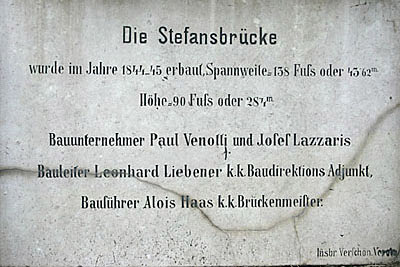History
The "Gasthof zur Stephansbrücke" was constructed in 1845. Back then it was used as a rest house and inn for travellers and business people who were travelling by horse and cart.
A farm building with large stables was constructed next to the inn. These stables were used to house waggoners' horses and the inn's own draft horses, teams of which people could rent to take them up over the Schönberg mountain. This additional service of renting out teams of horses was, back then, one of the main sources of income for the inn. Nowadays, the inn is owned by the fourth generation of the same family.
The actual Stefansbrücke bridge — which was also completed in 1845 — was 43 metres wide and 28 metres tall, making it one of the tallest stone arch bridges in Europe at the time. All the scaffolding for the construction of the bridge was made of wood.
The bridge was named after the person who laid its foundation stone: "Archduke Stefan", a great-grandson of Empress Maria Theresa. It was built within just two years, under Leonhard von Liebener.
The Papstl — a nearby stone monument built in 1782, featuring a marble inscription — commemorates the journey made by Pope Pius VI. He was accompanied from Vienna up to this point on his journey by the daughter of Empress Maria Theresa. There, Archduchess Maria Elizabeth took her leave of the high-ranking visitor, and the Pope continued on to Rome alone.
The small baroque church in the village was built in 1630 by Christian Lener, known as "the wealthy one".
The Roman road was the first crossing over the Schönberg mountain to Italy still built by the old Romans. The cobblestones laid then are still preserved in part today.
The earth pyramids — towers of stone and stand shaped by the elements — can best be seen from the Europabrücke bridge.

